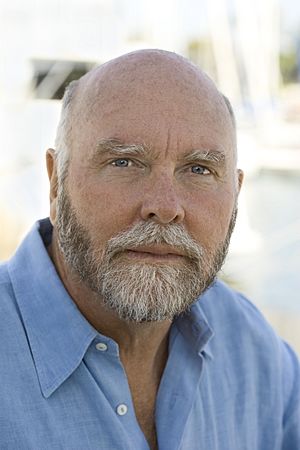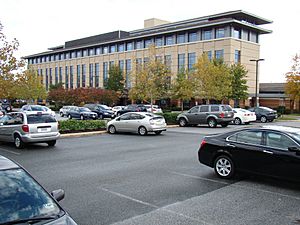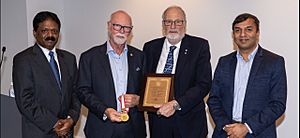Craig Venter facts for kids
Quick facts for kids
John Venter
|
|
|---|---|

Venter in 2007
|
|
| Born |
John Craig Venter
October 14, 1946 Salt Lake City, Utah, U.S.
|
| Alma mater | University of California, San Diego |
| Occupation | Biologist |
| Awards | Gairdner Award (2002) Nierenberg Prize (2007) Kistler Prize (2008) ENI award (2008) Medal of Science (2008) Dickson Prize (2011) Leeuwenhoek Medal Edogawa NICHE Prize (2020) |
| Scientific career | |
| Fields |
|
| Institutions | |
John Craig Venter (born October 14, 1946) is a famous American scientist. He is best known for his groundbreaking work on the human genome. This is like the complete instruction book for building a human.
Venter led one of the first teams to map the human genome. He also led the first team to put a man-made chromosome into a cell. He started important science organizations like Celera Genomics and the J. Craig Venter Institute. He was also a co-founder of Human Longevity Inc. and Synthetic Genomics.
Time magazine named him one of the 100 most influential people in the world in 2007 and 2008. In 2012, he received the Dan David Prize for his work in genome research.
Contents
Early Life and Education
John Craig Venter was born in Salt Lake City, Utah. His family later moved to Millbrae, California. When he was young, he loved spending time outdoors, especially surfing and boating. He was not a very serious student in his early years.
Venter joined the United States Navy during the Vietnam War. He worked as a medical helper in a hospital. Seeing many injured soldiers made him want to study medicine. He later decided to focus on biomedical research.
He started college in 1969 at College of San Mateo. He then went to the University of California, San Diego (UCSD). He earned a Bachelor of Science degree in biochemistry in 1972. In 1975, he received his Doctor of Philosophy degree in physiology and pharmacology from UCSD.
Career in Science
After college, Venter worked as a professor at the State University of New York at Buffalo. In 1984, he joined the National Institutes of Health (NIH).
Discovering ESTs
At the NIH, Venter found a new way to identify small pieces of DNA. He called these pieces expressed sequence tags, or ESTs. These ESTs helped scientists learn which genes were active in different parts of the body, like the human brain.
The NIH tried to get a patent for these ESTs. This caused a big debate because many people believed that genes should not be owned. The NIH later stopped trying to patent them.
The Human Genome Project
Venter strongly believed that understanding our genes could change healthcare. He thought a method called shotgun sequencing was the fastest way to map the human genome. However, the main Human Genome Project chose a different, slower method. They thought Venter's method might not be accurate enough for a complex human genome.
Venter saw a chance to speed things up. He got funding from a DNA sequencing company to start Celera Genomics. His company aimed to map the human genome faster and then charge for access to the data. This pushed the public Human Genome Project to work even harder.
In 2000, Venter and Francis Collins from the public project announced a major milestone. They had both completed a first draft of the human genome. This was three years earlier than expected! U.S. President Bill Clinton and UK Prime Minister Tony Blair were part of the announcement.
In February 2001, both the public project and Celera Genomics published their findings in top science journals. Even though some doubted shotgun sequencing, it became a widely accepted method. Venter later left Celera in 2002.
Exploring Ocean Life
Venter also led the Global Ocean Sampling Expedition (GOS). This project aimed to study the tiny living things in the ocean. It wanted to understand their genes and how they help nature.
The expedition started in 2003 and used Venter's personal yacht, Sorcerer II. The team sailed around the world, collecting samples and studying the DNA of ocean microbes. The journey finished in 2006.
Creating Synthetic Life
In 2005, Venter co-founded Synthetic Genomics. This company works on using changed microorganisms to make clean fuels and other chemicals. For example, they are working on creating special algae to produce biofuels.
In May 2010, Venter's team made a huge scientific breakthrough. They were the first to create what was called "synthetic life". They built a very long DNA molecule that contained an entire bacterium's genome. Then, they put this man-made DNA into another cell. This cell then started to work, controlled by the new synthetic DNA.
This new organism had special "watermarks" in its DNA. These watermarks were like hidden messages that showed it was man-made. They included the names of the scientists and some famous quotes.
In 2016, Venter's team created Syn 3.0. This was a synthetic genome with the fewest genes of any living organism. It had only 473 genes. The goal was to find the smallest number of genes needed for life. This tiny, fast-growing cell is a valuable tool for scientists.
In 2018, Venter stepped down as chairman of Synthetic Genomics. He wanted to focus more on his work at the J. Craig Venter Institute.
J. Craig Venter Institute
In 2006, Venter started the J. Craig Venter Institute (JCVI). This is a non-profit organization that does research in synthetic biology. It has locations in La Jolla, California, and Rockville, Maryland. Over 200 people work there.
In April 2022, Venter sold the La Jolla JCVI building to the University of California, San Diego. However, Venter is not retiring. He continues to lead a separate research group also called the J. Craig Venter Institute. The institute is growing and plans to move into a new, larger facility in 2025.
Sequencing His Own Genome
In 2007, a team led by Sam Levy published the complete DNA sequence of an individual human. That individual was John Venter himself! This was one of the first times a person's entire genetic code was mapped.
Scientists can now use special computer programs to look at Venter's genome. They can compare it to other human genomes. This helps them understand how genes might be linked to certain traits or health conditions.
Human Longevity, Inc.
In 2014, Venter co-founded Human Longevity, Inc. This company focuses on extending how long people can live healthy lives. They use advanced tools to study people's genes, metabolism, and tiny microbes in their bodies.
The company plans to sequence many genomes each year. They are especially interested in the genes of cancer patients. Venter served as the company's CEO until May 2018.
Books by Venter
John Venter has written three books. His first book is his autobiography, called A Life Decoded.
His second book, Life at the Speed of Light, talks about how computer programming and genetic programming (DNA) are becoming more similar.
Venter's most recent book is The Voyage of Sorcerer II: The Expedition that Unlocked the Secrets of the Ocean’s Microbiome. This book tells the story of the Global Ocean Sampling Expedition. It describes how scientists collected and sequenced the DNA of microbes from oceans around the world over 15 years.
Personal Life
John Venter lives in La Jolla, California, with his wife, Heather Kowalski. He also has a ranch in Borrego Springs, California, and homes in Maine.
Even though he sold one of his research buildings in 2022, Venter has said he has no plans to retire. He enjoys two main hobbies: sailing and flying his Cirrus 22T plane. He calls flying "the ultimate freedom."
Awards and Honors
Venter has received many awards for his scientific contributions:
- 1996: Golden Plate Award from the American Academy of Achievement
- 1999: Newcomb Cleveland Prize
- 2001: Biotechnology Heritage Award (with Francis Collins)
- 2002: Association for Molecular Pathology Award for Excellence in Molecular Diagnostics
- 2007: Honorary doctorates from Arizona State University and Imperial College London
- 2008: Double Helix Medal from Cold Spring Harbor Laboratory
- 2008: Kistler Prize for genome research
- 2008: ENI award for Research & Environment
- 2008: National Medal of Science from President Obama
- 2010: Honorary doctor of science degree from Clarkson University
- 2011: Benjamin Rush Medal from William & Mary School of Law
- 2011: Dickson Prize in Medicine for his work on the Human Genome
See also
 In Spanish: Craig Venter para niños
In Spanish: Craig Venter para niños
- Artificial gene synthesis
- Full genome sequencing
- Genetic testing
- Personal genomics
- Predictive medicine
- Synthetic Organism Designer



